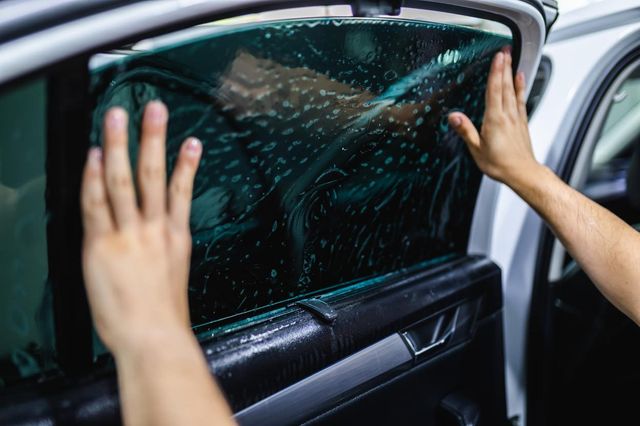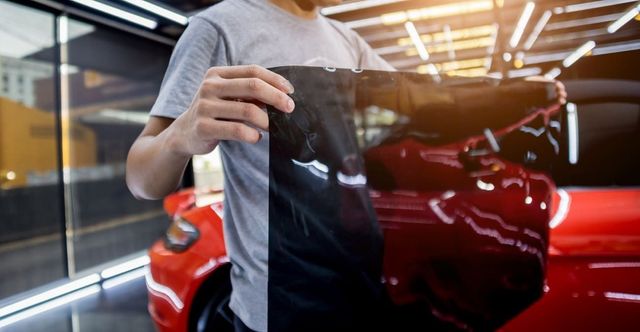A Comprehensive Guide to Comprehending Auto Home Window Color and Its Advantages
Vehicle home window tinting serves greater than simply an aesthetic purpose for lorries. It provides various kinds, each with unique functions and benefits. Recognizing these alternatives, together with lawful guidelines and maintenance ideas, is crucial for any kind of car proprietor. The advantages might greatly boost driving comfort and lorry durability. As one explores the subtleties of window tinting, the concern occurs: what kind of tint is ideal suited for specific needs?
Comprehending Vehicle Window Color: What It Is and Exactly how It Works
Auto home window tint functions as a safety barrier that improves lorry appearances while offering useful advantages. This slim movie is used to the interior surface of car windows, minimizing glow and obstructing unsafe ultraviolet (UV) rays from the sun. By filtering system sunlight, vehicle home window color aids to regulate the indoor temperature level of the vehicle, causing increased convenience for guests and reduced reliance on air conditioning.Additionally, it secures the automobile's interior from fading, preserving both upholstery and control panel materials. The color can additionally enhance personal privacy, making it harder for outsiders to see inside the vehicle. In addition, certain kinds of home window color can raise safety and security; in the occasion of a mishap, the film aids hold destroyed glass together, decreasing the threat of injury from flying shards. Overall, car home window color serves both useful and visual purposes, making it a prominent choice amongst vehicle owners.
Kinds of Home Window Color: An Introduction of Options
When taking into consideration home window tint choices, numerous types are readily available, each with distinctive characteristics. Colored, metalized, and ceramic home window tints offer differing degrees of warm denial, UV defense, and visual appeal. Recognizing these distinctions can help car proprietors make informed choices based on their requirements and choices.
Colored Home Window Color
Dyed window tint represents a popular choice among car owners seeking a economical and reliable means to boost their car's aesthetics and personal privacy. This type of color is produced by positioning a layer of color in between a sticky layer and a safety finish, leading to a darkened appearance that reduces glow and improves visual convenience. While colored window color effectively blocks dangerous UV rays, it may not use the exact same level of heat being rejected as other color kinds. In addition, its color can fade with time, potentially lessening its performance. In spite of these disadvantages, dyed window color stays favored for its cost-effectiveness and capacity to give a smooth, fashionable look to different car designs.
Metalized Home Window Tint
Metalized home window color supplies a balance of style and capability, making it a prominent option among auto owners. This sort of tint integrates metal fragments within the film, improving both visual charm and warm denial. The reflective quality of metalized color aids to lower glare and enhance privacy, while additionally offering UV defense, which safeguards the vehicle's interior. Furthermore, metalized window color can enhance home window toughness, possibly stopping shattering during accidents. Nevertheless, it is necessary to note that the metal parts can interfere with electronic signals, such as GPS and cell phone function. Overall, metalized home window color supplies an effective service for those looking for a combination of look, sun, and toughness security for their vehicles.
Ceramic Home Window Tint
Ceramic window color represents an advanced alternative in the spectrum of vehicle home window films, supplying distinctive advantages over traditional colors. Unlike dyed or metalized movies, ceramic tints use innovative ceramic bits, which efficiently reject heat and UV rays without endangering presence. This modern technology assures that automobiles remain cooler, reducing dependence on cooling and improving gas performance. Additionally, ceramic home window tints are less most likely to hinder electronic gadgets, such as GPS or mobile signals, making them a sensible choice for modern vehicles. Their resilience and scratch resistance contribute to a longer life-span contrasted to other kinds of colors. In general, ceramic home window tint offers exceptional efficiency, convenience, and security, making it a recommended option for critical lorry owners.
Benefits of Automobile Home Window Color: Beyond Visual Appeals
While lots of people associate auto home window tint with improved design, its benefits expand much beyond simple aesthetics. One considerable benefit is warmth decrease; home window tint can obstruct as much as 99% of dangerous UV rays, shielding and maintaining the interior cooler furniture from fading. This not just boosts comfort throughout heat however also minimizes dependence on a/c, causing enhanced gas efficiency.In addition, vehicle window color supplies an included layer of privacy and security. Tinted windows make it difficult for outsiders to see inside the lorry, which can hinder theft and shield valuables. In addition, numerous tints reinforce the glass, lowering the possibility of shattering in case of an accident, thus boosting safety.In addition to these useful advantages, automobile window color can likewise add to glare reduction, enhancing visibility for guests and drivers alike. This multifaceted strategy to comfort and safety and security makes window tint a useful financial investment for vehicle proprietors.
Legal Factors To Consider: Tinting Laws by State
Before committing to automobile home window tint, vehicle proprietors have to navigate a complex landscape of tinting laws that differ by state. Each state has details laws regulating the allowable degrees of color darkness and reflectivity for various home windows, including windscreens, front side home windows, and rear windows. These regulations usually consist of visible light transmission (VLT) percentages, which dictate just how much light can go through the tinted glass.Some states allow darker colors on back windows while restricting front side and windscreen colors for safety reasons. Furthermore, specific states might call for a certificate from the supplier to verify compliance with tinting legislations. Violating these guidelines can lead to penalties, mandatory elimination of the color, or both. It is vital for car proprietors to investigate their state's regulations thoroughly to guarantee legal conformity prior to setting up window tint. This diligence can conserve money and time in the future.
Selecting the Right Color: Factors to Take into consideration
When selecting the ideal home window color for an automobile, several vital aspects come into play. Color darkness levels, UV defense rankings, and compliance with legal guidelines are important factors to consider to guarantee both visual appeals and functionality. Evaluating these aspects will aid individuals make an educated decision that meets their requirements and abides by regional regulations.
Tint Darkness Levels
Picking the appropriate tint darkness degree is crucial for attaining the preferred equilibrium between visual appeals and functionality in car window tinting. Various states have differing lawful guidelines pertaining to tint darkness, which can impact the selection. Usually, colors are measured in portions, with lower percentages suggesting darker tones. Darker tints use raised privacy and a smooth appearance yet can lower visibility, specifically in the evening. Conversely, lighter tints preserve a more open feeling, making sure adequate exposure while still supplying some warm and glare reduction. When making a choice, individuals should consider their driving routines, regional regulations, and individual preferences. Ultimately, the ideal color darkness level boosts the car's look while making certain security and conformity with lawful standards.
UV Security Rating
Tint darkness degrees play a substantial role in the general performance of vehicle home window tinting, yet an additional vital variable to evaluate is the UV protection click here score of the picked color. This score suggests the percentage of damaging ultraviolet rays that the tint can obstruct. Top quality colors commonly give 99% or more UV protection, guarding guests and the car's inside from sunlight damage. Davinci of Michigan. Prolonged direct exposure to UV rays can result in skin issues and fading of furniture, making a high UV defense ranking crucial for wellness and long life. When selecting home window tint, consumers must prioritize this score alongside darkness levels to assure maximum convenience and safety and security while driving. Understanding these aspects aids in making an informed decision when buying vehicle window tinting
Legal Laws Compliance
Understanding regional legal guidelines is crucial for anybody thinking about car window tinting. Each state or area has particular legislations governing the permitted levels of tint darkness and reflectivity for different home windows. These regulations typically define the noticeable light transmission percentage, figuring out just how much light can travel through the colored glass. Non-compliance can cause penalties, mandatory removal of the tint, or problems throughout vehicle assessments. Additionally, some locations might have restrictions on using certain tinting products, requiring consumers to select products that satisfy safety and security criteria. It is important for vehicle proprietors to research their regional regulations completely prior to choosing home window color to guarantee compliance and stay clear of prospective lawful problems.

Installment Process: DIY vs. Professional Solutions
How does one choose in between a DIY installment and hiring expert solutions for auto home window tinting? The option frequently rests on spending plan, experience, and desired results. A DIY approach can be cost-effective, enabling individuals to reduce labor expenses. It requires a certain level of skill and understanding about the tinting process. Those that are thorough and person may locate success with do it yourself kits available in the market.Conversely, specialist solutions use knowledge and high-quality products, making certain a flawless surface. Specialists usually guarantee their job, offering satisfaction versus prospective problems such as peeling or gurgling. Additionally, they know with regional regulations regarding tinting, which can be intricate for the typical auto owner.Ultimately, the choice mirrors an equilibrium between cost, personal capacity, and the expected high quality of the tinting task. Each alternative has its benefits, and the very best option relies on individual scenarios and choices.
Maintenance Tips: Keeping Your Tint in Top Condition

Often Asked Concerns
The Length Of Time Does Home Window Tint Generally Last on a Vehicle?
Window color generally lasts in between 5 to 10 years, relying on factors such as high quality, application, and environmental conditions. Regular upkeep and proper care can expand its life expectancy, ensuring optimal performance and look with time.
Can Window Tinting Damages My Auto's Original Glass?
Home window tinting, when applied correctly, does not damage an auto's original glass. Inappropriate installment or low-quality products may lead to issues like peeling or bubbling, possibly influencing the glass's honesty over time.
Is Window Tinting Safe for All Kinds of Automobiles?
Home window tinting is typically risk-free for a lot of cars, supplied the film follows local laws and is appropriately applied. Nonetheless, some customized automobiles might need certain considerations, making it necessary to get in touch with experts before installment.
Will Home Window Tinting Space My Vehicle Service Warranty?
The inquiry of whether home window tinting gaps an auto service warranty frequently relies on the manufacturer's policies. Typically, if the color does not harm the lorry, warranties normally stay undamaged. However, getting in touch with the supplier is suggested.
Can I Eliminate Home Window Tint Myself if Needed?
Removing home window tint oneself is feasible, yet it calls for mindful interest to avoid damaging the glass. People ought to utilize suitable tools and methods to assure a successful removal without leaving glue residue or scratches behind. While dyed window tint successfully blocks damaging UV rays, it may not use the very same degree of warm being rejected as various other color kinds. Ceramic home window color stands for an innovative choice in the range of vehicle window films, providing distinct benefits over typical tints. Prior to committing to automobile window tint, car proprietors have to navigate a complicated landscape of tinting guidelines that differ by state. These regulations commonly include visible light transmission (VLT) percentages, which dictate how much light can pass with the colored glass.Some states permit darker tints on back home windows while restricting front side and windscreen colors for security reasons. Tint darkness degrees play a substantial function in the overall effectiveness of vehicle window tinting, yet an additional important aspect to review is the UV protection rating of the selected color.